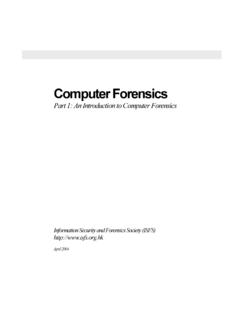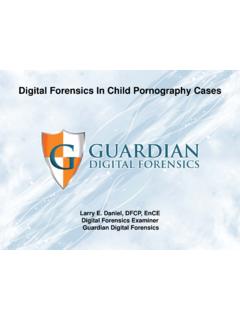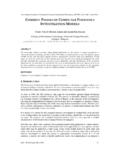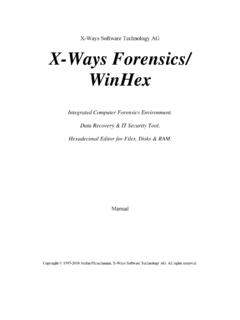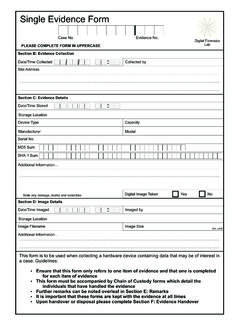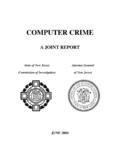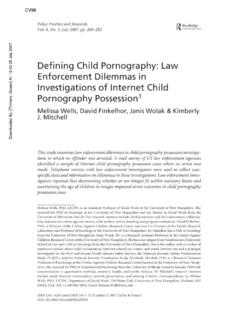Transcription of File System Forensic Analysis.pdf - Campus64
1 2 ! " # $ % $ # &' ( ! " ) * # & + # ( ! "! ! # $! ! % ! " ) ! "( ( $ & ' ! " ) , * % * -( ( $ # ) &&' . ( ! " /) . ( # ! " ) ! 0 $ # # ! * 3 ! " ) + 0 + ! " ) ( " * % . ( # &&&' ! " ) ( , - , * , # # . ! / , ! " 1) 2 ! " , * , $ ! " ) 2 * ( ( ,# 01 , ,$ ,# " 2 , " 4 ! " ) 32 ! " "! , *, *, " # $ # 3 # ! " ) 32 , * , # $ ! " ) 32 * ( ( , # 3 # , * , ! " /) 45 45 ! " , * , # $ ! " ) 45 45 * ( ( + 5 "3 # " 2 ' 4 ! " ) 6 6 ! " , * , $ ! " ) 6 6 * ( ( ), 5 ), 1 + ), 5 + ), 1 + , ), 5 ), 1 ), 1 "3 # " "" 5 ) 2 ( 7 ( " 6 # 6 Copyright Many of the designations used by manufacturers and sellers to distinguish their products are claimed as trademarks.
2 Where those designations appear in this book, and the publisher was aware of a trademark claim, the designations have been printed with initial capital letters or in all capitals. The author and publisher have taken care in the preparation of this book, but make no expressed or implied warranty of any kind and assume no responsibility for errors or omissions. No liability is assumed for incidental or consequential damages in connection with or arising out of the use of the information or programs contained herein. The publisher offers excellent discounts on this book when ordered in quantity for bulk purchases or special sales, which may include electronic versions and/or custom covers and content particular to your business, training goals, marketing focus, and branding interests.
3 For more information, please contact: U. S. Corporate and Government Sales (800) 382-3419 For sales outside the U. S., please contact: International Sales Visit us on the Web: Library of Congress Catalog Number: 2004116962 Copyright 2005 Pearson Education, Inc. All rights reserved. Printed in the United States of America. This publication is protected by copyright, and permission must be obtained from the publisher prior to any prohibited reproduction, storage in a retrieval System , or transmission in any form or by any means, electronic, mechanical, photocopying, recording, or likewise. For information regarding permissions, write to Pearson Education, Inc. Rights and Contracts Department One Lake Street Upper Saddle River, NJ 07458 ISBN 0-32-126817-2 Text printed in the United States on recycled paper at R.
4 R. Donnelley in Crawfordsville, Indiana. First printing, March 2005 Dedication THIS BOOK IS DEDICATED TO MY GRANDPARENTS, HENRI, GABRIELLE, ALBERT, AND RITA 7 Foreword computer forensics is a relatively new field, and over the years it has been called many things: " computer forensics," "digital forensics," and "media analysis " to name a few. It has only been in the past few years that we have begun to recognize that all of our digital devices leave digital breadcrumbs and that these breadcrumbs are valuable evidence in a wide range of inquiries. While criminal justice professionals were some of the first to take an interest in this digital evidence, the intelligence, information security, and civil law fields have enthusiastically adopted this new source of information.
5 Digital forensics has joined the mainstream. In 2003, the American Society of Crime Laboratory Directors Laboratory Accreditation Board (ASCLD LAB) recognized digital evidence as a full-fledged Forensic discipline. Along with this acceptance came increased interest in training and education in this field. The computer Forensic Educator's Working Group (now known as the Digital Forensic Working Group) was formed to assist educators in developing programs in this field. There are now over three-dozen colleges and universities that have, or are, developing programs in this field. More join their ranks each month. I have had the pleasure of working with many law enforcement agencies, training organizations, colleges, and universities to develop digital Forensic programs.
6 One of the first questions that I am asked is if I can recommend a good textbook for their course or courses. There have been many books written about this field. Most take a targeted approach to a particular investigative approach, such as incident response or criminal investigation. Some tend to be how-to manuals for specific tools. It has been hard to find a book that provides a solid technical and process foundation for the field .. That is, until now. This book is the foundational book for file System analysis . It is thorough, complete, and well organized. Brian Carrier has done what needed to be done for this field. This book provides a solid understanding of both the structures that make up different file systems and how these structures work.
7 Carrier has written this book in such a way that the readers can use what they know about one file System to learn another. This book will be invaluable as a textbook and as a reference and needs to be on the shelf of every digital Forensic practitioner and educator. It will also provide accessible reading for those who want to understand subjects such as data recovery. When I was first approached about writing this Foreword, I was excited! I have known Brian Carrier for a number of years and I have always been impressed with his wonderful balance of incredible technical expertise and his ability to clearly explain not just what he knows but, more importantly, what you need to know. Brian's work on Autopsy and The Sleuth Kit (TSK) has demonstrated his command of this field his name is a household name in the digital Forensic community.
8 I have been privileged to work with Brian in his current role at Purdue University, and he is helping to do for the academic community what he did for the commercial sector: He set a high standard. So, it is without reservation that I recommend this book to you. It will provide you with a solid foundation in digital media. Mark M. Pollitt President, Digital Evidence Professional Services, Inc. Retired Director of the FBI's Regional computer Forensic Laboratory Program 8 Preface One of the biggest challenges that I have faced over the years while developing The Sleuth Kit (TSK) has been finding good file and volume System (such as partition tables, RAID, and so on) documentation. It also has been challenging to explain to users why certain files cannot be recovered or what to do when a corrupt file System is encountered because there are no good references to recommend.
9 It is easy to find resources that describe file systems at a high level, but source code is typically needed to learn the details. My goal for this book is to fill the void and describe how data are stored on disk and describe where and how digital evidence can be found. There are two target audiences for this book. One is the experienced investigator that has learned about digital investigations from real cases and using analysis tools. The other is someone who is new to the field and is interested in learning about the general theory of an investigation and where digital evidence may exist but is not yet looking for a book that has a tutorial on how to use a specific tool. The value of the material in this book is that it helps to provide an education rather than training on a specific tool.
10 Consider some of the more formal sciences or engineering disciplines. All undergraduates are required to take a couple of semesters of physics, chemistry, or biology. These courses are not required because the students will be using all the material for the rest of their careers. In fact, software and equipment exist to perform many of the calculations students are forced to memorize. The point of the classes is to provide students with insight about how things work so that they are not constrained by their tools. The goal of this book is to provide an investigator with an education similar to what Chemistry 101 is to a chemist in a forensics lab. The majority of digital evidence is found on a disk, and knowing how and why the evidence exists can help an investigator to better testify about it.
